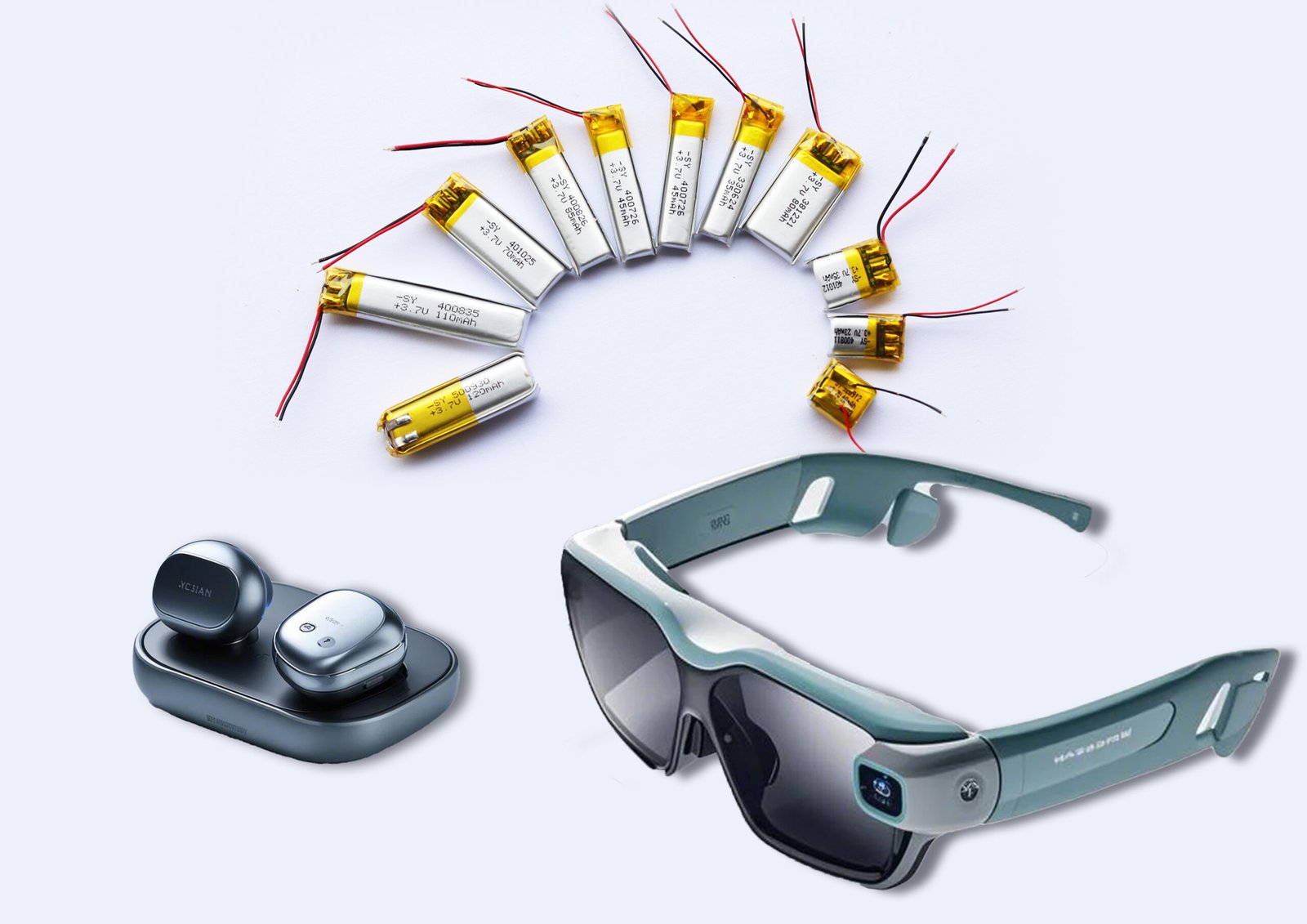
When your smart glasses run out of power faster than expected, it's frustrating—and replacing the battery isn’t always simple.
Smart glasses batteries typically last 1 to 3 years before needing replacement, depending on battery type, usage habits, and charging practices.
If you're using smart glasses daily or integrating them into work environments, understanding battery longevity can help you plan ahead, avoid device downtime, and make better buying decisions.
Table of Contents
ToggleTable of Contents
- Types of Batteries: Which Last Longer?
- Does Battery Capacity Dictate Lifespan?
- How Do Smart Features Drain the Battery?
- What Role Do Your Habits Play?
- Can Charging Habits Kill a Battery Faster?
- Is the Environment Killing Your Battery?
- How to Track Battery Health Over Time?
- When Exactly Should You Replace It?
- What Do Other Users Say?
- What's Coming Next?
Types of Batteries: Which Last Longer?
When it comes to battery life, not all batteries are created equal.
Smart glasses typically use either lithium-ion (Li-ion) or lithium polymer (Li-Po) batteries. Li-ion lasts longer in cycles, while Li-Po allows for sleeker designs.

Li-ion vs. Li-Po: What's the Real Difference?
| Feature | Li-ion | Li-Po |
|---|---|---|
| Energy Density | Higher | Moderate |
| Flexibility | Rigid | Flexible |
| Lifespan (Cycles) | ~500–1000 | ~300–500 |
| Cost | Cheaper | Slightly more expensive |
| Safety | Good with protection circuits | Slightly safer by chemistry |
Li-ion batteries can last longer—up to three years—if properly charged and not exposed to extreme heat. But Li-Po’s flexibility gives manufacturers more freedom in device design. This is important because space is tight inside wearable tech.
Manufacturers often choose based on size constraints rather than battery longevity. That’s something to remember when evaluating devices.
Does Battery Capacity Dictate Lifespan?
Battery capacity isn't just about how long your smart glasses run in a day—it also plays a part in how long the battery will live overall.
Battery capacity (mAh) affects how long your smart glasses run between charges but does not directly dictate replacement cycles.

The Real Relationship Between mAh and Life Expectancy
Most smart glasses come with batteries between 300mAh and 800mAh. Here's how that typically translates into usage:
| Battery Capacity | Typical Usage Time | Estimated Years Before Decline |
|---|---|---|
| 300 mAh | 2–3 hours | ~1–2 years |
| 500 mAh | 4–5 hours | ~2–3 years |
| 800 mAh | 6–8 hours | ~3 years |
The bigger the battery, the fewer charge cycles it may go through in a day—which helps extend lifespan. But keep in mind: software efficiency and hardware design also matter.
Power-hungry features like AR displays and cameras can make even a large battery feel small.
How Do Smart Features Drain the Battery?
Smart glasses are essentially mini-computers on your face. And just like any computer, some functions drain power faster than others.
High-drain features like video streaming, AR overlays, and GPS tracking significantly reduce daily runtime and battery life over time.

Which Features Are Killing the Battery?
| Feature | Power Usage Level | Impact on Battery Health |
|---|---|---|
| Video recording (HD) | Very High | Shortens lifespan |
| AR overlay display | High | Shortens lifespan |
| Bluetooth audio | Medium | Moderate |
| GPS tracking | Medium–High | Shortens lifespan |
| Idle with notifications | Low | Minimal |
Running heavy features continuously means more frequent charging, which leads to faster battery aging.
To mitigate this, users can disable features when not needed or limit usage duration.
What Role Do Your Habits Play?
How you use your smart glasses daily can make or break the battery.
Frequent full discharges, excessive app usage, and leaving the device on all day can cut battery lifespan in half.

Bad Habits That Destroy Batteries
- Using full brightness 100% of the time.
- Letting battery drain to 0% frequently.
- Leaving glasses charging overnight every night.
- Running AR features or camera all day.
Good Habits for Longer Battery Life
- Keep battery between 20% and 80%.
- Use battery saver modes when available.
- Shut down unused features (Wi-Fi, AR, etc.).
- Update firmware to optimize power usage.
Small adjustments in daily habits can add months or even a year to your battery’s life.
Can Charging Habits Kill a Battery Faster?
Charging may seem harmless, but it’s one of the biggest factors in battery degradation.
Charging too frequently, too fast, or without breaks can overheat batteries and shorten lifespan.

Smart Charging = Long Life
Most smart glasses support micro USB or magnetic dock charging with current-limiting circuits. However, fast charging (like 2C or 3C rates) can stress the battery.
| Charging Style | Charging Time | Battery Impact |
|---|---|---|
| Standard (0.5C–1C) | 1.5–2 hours | Minimal aging |
| Fast Charging (2C) | ~30 min | Higher heat, faster aging |
| Overnight Charging | 6–8 hours | Risk of trickle charge damage |
Ideally, you should charge once daily and unplug when it hits 80%–90%. Avoid charging in hot environments or while in use.
Is the Environment Killing Your Battery?
Smart glasses batteries are sensitive to temperature swings.
Exposure to extreme cold or heat reduces battery capacity and accelerates wear.

Environmental Danger Zones
| Condition | Effect on Battery |
|---|---|
| Below 0°C (32°F) | Reduced capacity, slower charging |
| Above 35°C (95°F) | Faster degradation, possible swelling |
| Humid environment | Risk of internal corrosion |
| Direct sunlight | Surface heat buildup |
If you're using your smart glasses in the field—like construction or outdoor sports—you’ll need to store them in protective cases and avoid direct exposure.
How to Track Battery Health Over Time?
You can’t fix what you can’t see. That applies to battery health, too.
Most smart glasses don’t include built-in battery health tools, so users must track charge times, usage hours, and warming trends manually.
How to Self-Monitor
- Check how long it takes to charge from 20% to 80% (should be ~1 hour).
- Measure runtime per full charge every 2 weeks.
- Note any warming during use or charging.
Once runtime drops by 30%–50% from when new, it’s time to consider replacement or repair.
When Exactly Should You Replace It?
There’s no fixed countdown, but several signs signal the end.
Replace your smart glasses battery if runtime drops below 2 hours, charging becomes irregular, or the device gets unusually warm.
Look out for:
- Full charge doesn’t last even half a day.
- Glasses shut off at random.
- Battery bulge or physical deformation.
- Charging cable or dock becomes unreliable.
Replacement typically involves sending the device to the manufacturer or authorized service provider. Most models do not have user-replaceable batteries.
What Do Other Users Say?
User experiences vary, but patterns emerge.
Most users report 18–24 months of solid performance before issues begin. Power users experience decline sooner.
Common Complaints
- “Battery dropped from 6 to 2 hours after a year.”
- “Used them for field inspections; by year two, they wouldn’t last more than an hour.”
- “AR overlays drain too fast; I had to buy two pairs.”
Many users wish manufacturers offered battery upgrade options or swappable modules—but those remain rare in 2025.
What’s Coming Next?
Battery tech is improving fast—and it might save your next pair.
Emerging solutions like graphene batteries and solid-state cells could double life expectancy and charge in minutes.
On the Horizon
- Graphene-enhanced cells: Charge faster, last longer.
- Flexible solid-state batteries: Safer and more compact.
- AI power management: Predicts usage and adjusts performance in real-time.
While these aren’t yet mainstream in consumer smart glasses, they’re in testing stages and could appear in the next 2–3 years.
Conclusion
Battery life in smart glasses depends on design, usage, and care—but with good habits, most last 2–3 years before needing replacement.

